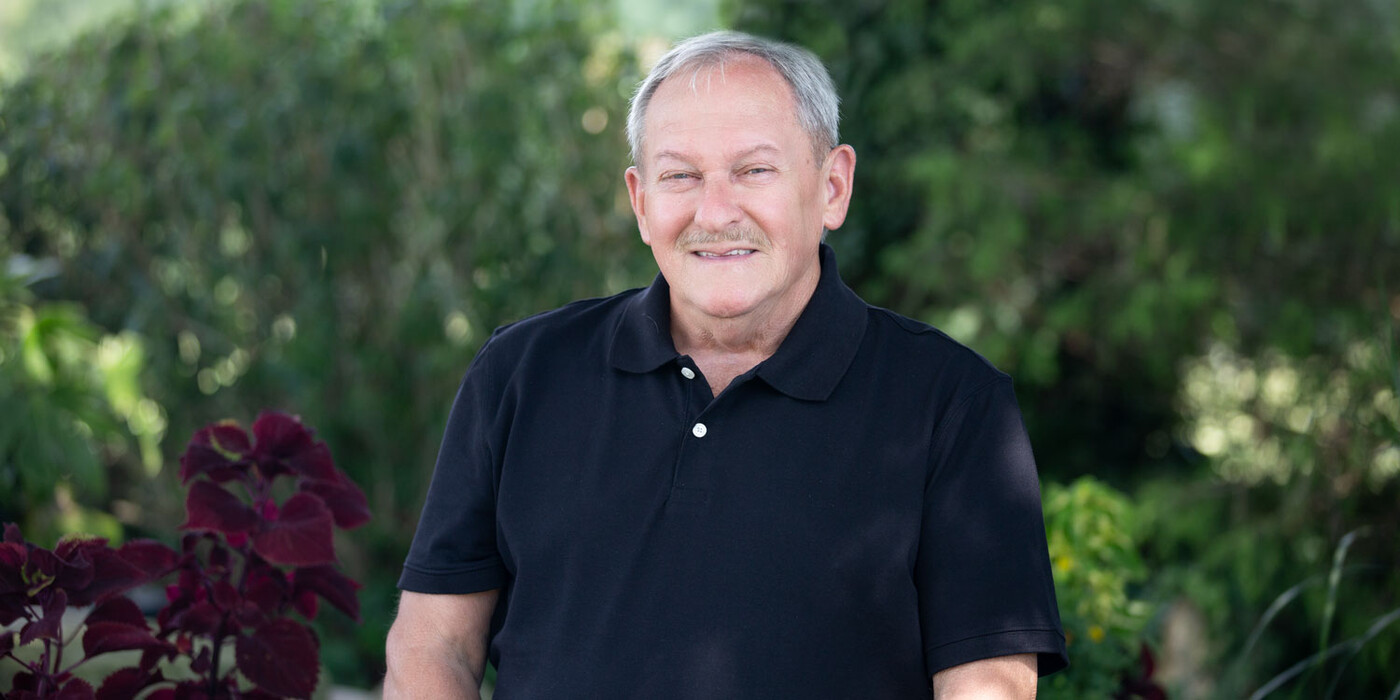Man Keeps His Voice After Partial Laryngectomy Treats Laryngeal Cancer

Dale Jessup, 71, smiles outside his home in Pinnacle, NC.
Dale Jessup, 71, was diagnosed with voice box cancer (also known as laryngeal cancer) in late 2017. Despite radiation treatment, Jessup’s cancer returned in January 2019. Doctors near his home in Pinnacle, NC recommended a total laryngectomy, which would surgically remove his entire voice box. This would require Jessup to breathe through a tube in his neck for the rest of his life, and he would lose his ability to speak naturally. Jessup sought a second opinion at Duke, where surgical oncologist Russel Kahmke, MD, offered a partial laryngectomy -- Dr. Kahmke would remove Jessup’s cancerous tumor but leave the rest of his voice box intact. This would preserve his ability to breathe and speak normally. Five years later, Jessup remains cancer-free and is grateful for being able to tell his story.
Voice Box Cancer Returns
When Dale Jessup’s laryngeal cancer returned in 2019, his doctors told him a total laryngectomy was his safest option due to the location of his tumor and side effects from previous radiation treatment. When his friend suggested he go to Duke, Jessup made an appointment with Dr. Kahmke.
“People can have a long, full life after a total laryngectomy, but communication, swallowing, and breathing are different,” Dr. Kahmke said. “A total laryngectomy separates swallowing and breathing functions, so everything that goes in the mouth just goes straight into the esophagus, down into the stomach, and you end up breathing through a hole in your neck.”
Weighing the Options
Dr. Kahmke used an endoscope, a flexible tube with a camera on the end, to examine Jessup’s voice box. He saw that the tumor was in a favorable location, above the vocal cords on what's called the supraglottic larynx. Because Jessup was otherwise in good health, Kahmke planned a partial laryngectomy during which he would access the tumor through Jessup’s mouth, rather than make an incision in Jessup’s throat (which would take longer to heal).
“There were risks, but I felt we could try, knowing that if it couldn’t be done, we would convert to a total laryngectomy,” Dr. Kahmke said. “I think Mr. Jessup was relieved to know that it was an option.”
Partial Laryngectomy Preserves Function
Before he was wheeled into surgery, Jessup thought about how he could wake up without a voice, but “there was something about Dr. Kahmke that I trusted,” he said. “I had to put my faith in God to guide his hands.”
When Jessup woke up after the surgery, he was relieved to learn that his voice box was still in place. Jessup couldn’t test his voice out just yet because of a temporary tracheostomy -- a hole in his neck he used to breathe until the post-surgical swelling went down. He also had a temporary feeding tube. A few days later during daily rounds, a doctor covered Jessup’s tracheostomy opening and told him to try speaking. “All of a sudden I heard myself talking,” he said. “It was a moment of jubilation!”
Recovery and a Follow-Up Regimen
Jessup’s recovery has been bumpy at times, but he maintained steady progress thanks to his hard work in swallowing therapy and voice therapy. Eventually his tracheostomy and feeding tube were removed. Today, he avoids certain foods, and he has trouble breathing in hot, hazy weather or if he gets a respiratory virus, but it’s a trade he’s glad he made.
“His goal was to be able to talk,” Dr. Kahmke said. “As doctors, we can't always give people what they want, but in Mr. Jessup's case, I’m glad we were able to preserve his function and also treat his cancer successfully.”
Jessup said Dr. Kahmke has been very conscientious with his follow-up and continuing care. He consistently identifies any problems and is quick to solve them. “He always assures me that he is available to help me in any way. This is so comforting to me and relieves my stress and anxiety about the cancer returning. I know I’m in good hands.”




